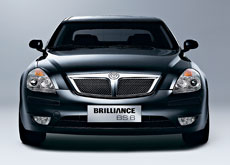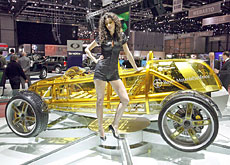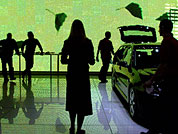Chinese cars gun for European market

For the first time in its long history the Geneva International Motor Show is playing host to a Chinese manufacturer.
Brilliance, based in Shenyang, is looking to use the annual event as a springboard for cracking the Swiss and European markets. But are motorists ready to buy a Chinese car?
One man who has no doubts is Hans-Ulrich Sachs, chairman and managing director of HSO Motors Europe, which is responsible for setting up a distribution network for Brilliance.
He dismisses talk of the poor reliability and poor reputation of Chinese cars as not something that concerns Brilliance.
“We have well-proven technology as far as the engine and the gearbox are concerned – a Mitsubishi engine and Mitsubishi gearbox – so there are no surprises. Reliability is not really an issue for us,” he told swissinfo.
As for why someone should buy the Brilliance BS6 saloon, Sachs is equally forthright: “Because it’s big, it has a lot of features – for instance leather, automatic air conditioning, distance parking control – and it has an appropriate price.”
In Switzerland, which has been identified by HSO as a priority market along with Germany, France, Austria, Belgium and the Netherlands, the car will sell for SFr28,000-30,000 ($23,000-24,600).
But while reliability may not be a problem for Brilliance, it is a weakness that appears to plague much of China’s automobile industry.
According to the French-language version of Switzerland’s Automobile Review magazine, up to 80 per cent of Chinese models are affected by more or less serious faults within the first six months.
Yet a recent article in The Economist painted a somewhat rosier picture for the future of Chinese-built cars.
It said the Roewe 750 saloon, produced by state-owned car maker SAIC, could prove to be the first to buck the trend because of greater attention to design and technology.
Packs potential
Matthias Pfannmüller, a journalist at the German language version of Automobile Review who has test-driven the Brilliance BS6, agrees with the view that the Chinese car industry packs potential but is not quite there yet.
He says that considering the Chinese only started building cars 15-20 years ago, they have made rapid progress – quicker than the Japanese and the South Koreans before them.
“If you look at South Korea, for instance, they started in the 70s and look at them today. They learned so fast and the Chinese will learn even faster. So the Chinese cars we see right now are just the beginning,” he said.
Pfannmüller states that the big advantage the Chinese have is the support they get from western car manufacturers.
The infant Chinese market represents rich pickings for western manufacturers that can gain a foothold. But for the moment the only way in is through tie-ups with local partners.
Joint ventures
For instance, Brilliance has a joint venture with German car manufacturer BMW to produce BMW’s 3 and 5 Series in Shenyang. SAIC has joint ventures with General Motors and Volkswagen.
“If you look at the new [Brilliance] BS4, which will be in Geneva, you will see certain styling cues reminding you of the 5 Series. Although there are no technical similarities, these cars come from the same production lines,” said Pfannmüller.
“By far the biggest impact on the development of Chinese manufacturers is the fact that European manufacturers in China have to cooperate with the Chinese. This is where they get their production knowledge and modern technologies from,” he added.
Even so, Pfannmüller believes it will still be another decade before the Chinese really break into the European market. But this still begs the question as to why they would want to do so when they are sitting on such a huge, untapped market back home.
“We think they do it in order to get better credibility and to improve their image for the home market. If Brilliance comes along and says, ‘listen we’re a sort of Chinese Mercedes Benz and we actually export our cars to Europe’, this could be a selling point.”
swissinfo, Adam Beaumont in Geneva
According to the Chinese car importer Asie Auto:
China became the world’s second-largest market for new vehicles in 2006 after the United States.
7.28 million vehicles were produced in 2006 (up 27.3% on the previous year), making China the third-largest producer in the world.
7.22 million units were sold in 2006 (up 25.1 % year on year).
Sales are predicted to grow by 15% to exceed 8 million units in 2007.
The Geneva International Motor Show covers almost 77,000 square metres and includes over 250 exhibitors.
Around 700,000 visitors are expected to attend the event, 40% from abroad. Over 80 world and European premieres are taking place in the vehicle sector alone. The exhibition runs until March 18.
The Asia Motor Group (Switzerland), which has its head office in Zug, will sell the Brilliance brand in Switzerland and Lichtenstein.

In compliance with the JTI standards
More: SWI swissinfo.ch certified by the Journalism Trust Initiative


You can find an overview of ongoing debates with our journalists here. Please join us!
If you want to start a conversation about a topic raised in this article or want to report factual errors, email us at english@swissinfo.ch.